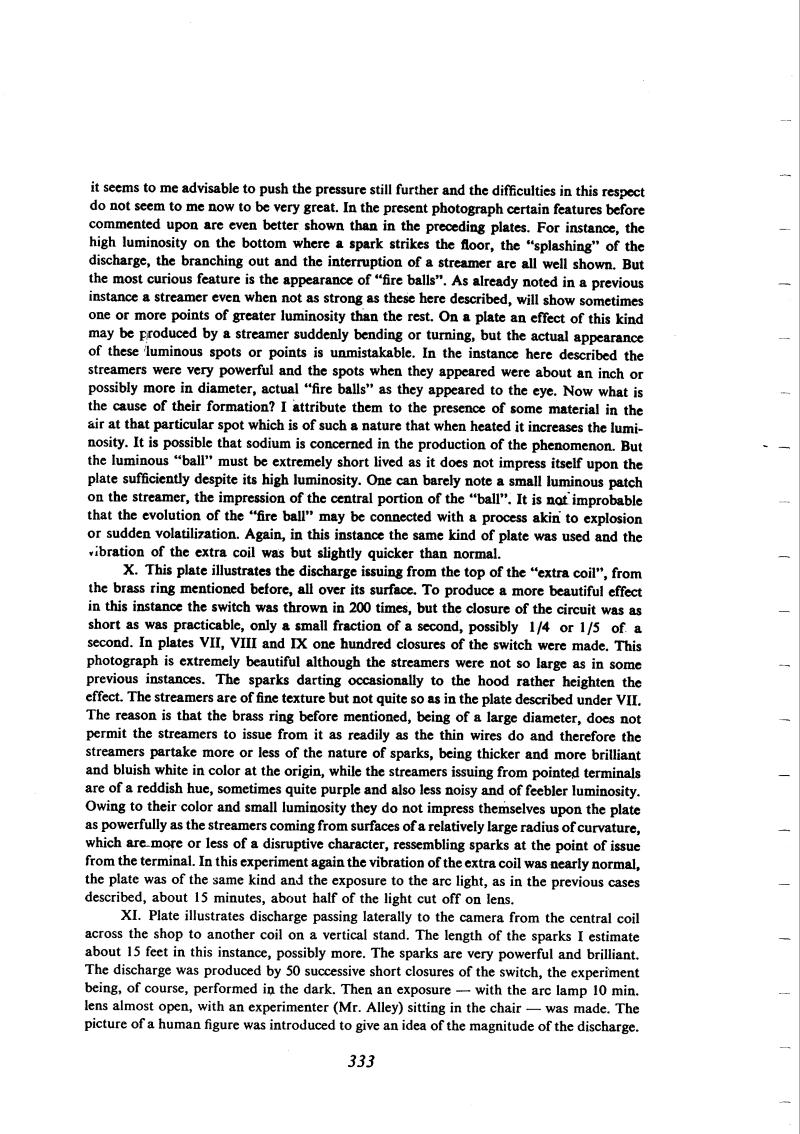
Nikola Tesla Books
it seems to me advisable to push the pressure still further and the difficulties in this respect do not seem to me now to be very great. In the present photograph certain features before commented upon are even better shown than in the preceding plates. For instance, the high luminosity on the bottom where a spark strikes the floor, the “splashing” of the discharge, the branching out and the interruption of a streamer are all well shown. But the most curious feature is the appearance of “fire balls”. As already noted in a previous instance a streamer even when not as strong as these here described, will show sometimes one or more points of greater luminosity than the rest. On a plate an effect of this kind may be produced by a streamer suddenly bending or turning, but the actual appearance of these luminous spots or points is unmistakable. In the instance here described the streamers were very powerful and the spots when they appeared were about an inch or possibly more in diameter, actual “fire balls” as they appeared to the eye. Now what is the cause of their formation? I attribute them to the presence of some material in the air at that particular spot which is of such a nature that when heated it increases the luminosity. It is possible that sodium is concerned in the production of the phenomenon. But the luminous “ball” must be extremely short lived as it does not impress itself upon the plate sufficiently despite its high luminosity. One can barely note a small luminous patch on the streamer, the impression of the central portion of the “ball”. It is not improbable that the evolution of the “fire ball” may be connected with a process akin to explosion or sudden volatilization. Again, in this instance the same kind of plate was used and the vibration of the extra coil was but slightly quicker than normal.
X. This plate illustrates the discharge issuing from the top of the “extra coil”, from the brass ring mentioned before, all over its surface. To produce a more beautiful effect in this instance the switch was thrown in 200 times, but the closure of the circuit was as short as was practicable, only a small fraction of a second, possibly 1/4 or 1/5 of a second. In plates VII, VIII and IX one hundred closures of the switch were made. This photograph is extremely beautiful although the streamers were not so large as in some previous instances. The sparks darting occasionally to the hood rather heighten the effect. The streamers are of fine texture but not quite so as in the plate described under VII. The reason is that the brass ring before mentioned, being of a large diameter, does not permit the streamers to issue from it as readily as the thin wires do and therefore the streamers partake more or less of the nature of sparks, being thicker and more brilliant and bluish white in color at the origin, while the streamers issuing from pointed terminals are of a reddish hue, sometimes quite purple and also less noisy and of feebler luminosity. Owing to their color and small luminosity they do not impress themselves upon the plate as powerfully as the streamers coming from surfaces of a relatively large radius of curvature, which are more or less of a disruptive character, ressembling sparks at the point of issue from the terminal. In this experiment again the vibration of the extra coil was nearly normal, the plate was of the same kind and the exposure to the arc light, as in the previous cases described, about 15 minutes, about half of the light cut off on lens.
XI. Plate illustrates discharge passing laterally to the camera from the central coil across the shop to another coil on a vertical stand. The length of the sparks I estimate about 15 feet in this instance, possibly more. The sparks are very powerful and brilliant. The discharge was produced by 50 successive short closures of the switch, the experiment being, of course, performed in the dark. Then an exposure - with the arc lamp 10 min. lens almost open, with an experimenter (Mr. Alley) sitting in the chair - was made. The picture of a human figure was introduced to give an idea of the magnitude of the discharge.
333

